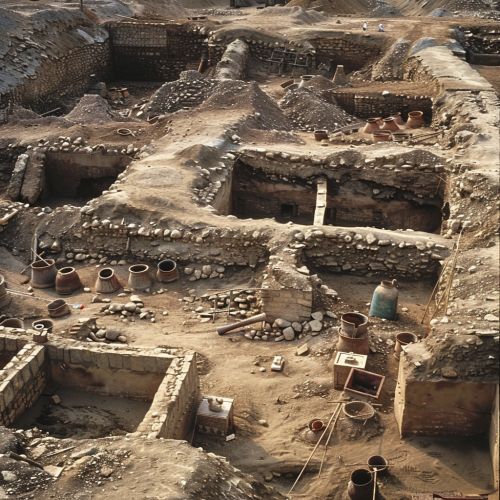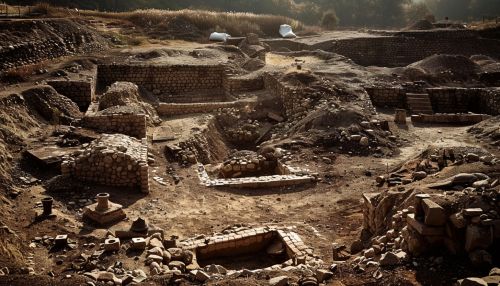Historical Archaeology
Introduction
Historical archaeology is the study of cultures with some form of writing. Unlike prehistoric archaeology, which studies societies without written records, historical archaeology focuses on societies that have left behind documents and other forms of written evidence. This field of study combines the use of historical records with archaeological investigation to gain a more comprehensive understanding of the past.
Origins and Development
Historical archaeology as a distinct field began to take shape in the late 19th and early 20th centuries. Early practitioners were often historians or amateur antiquarians who used archaeological methods to supplement their historical research. The field began to professionalize in the mid-20th century, with the establishment of dedicated academic programs and professional societies such as the Society for Historical Archaeology.


Methodology
Historical archaeologists employ a variety of methods to investigate the past. These include excavation, survey, and the analysis of artifacts, ecofacts, and features. In addition, historical archaeologists often use written records, oral histories, and other forms of historical data to supplement their archaeological research.
Excavation
Excavation is the process of digging up and recording archaeological sites. Historical archaeologists often excavate sites that are threatened by development or natural processes. They also excavate sites that have the potential to provide new insights into the past.
Survey
Survey is the process of systematically searching for archaeological sites. This can be done on foot, by car, or with the use of remote sensing technologies such as GIS and LiDAR. Surveys can provide valuable information about the distribution and density of archaeological sites in a given area.
Artifact Analysis
Artifact analysis involves the study of objects made or used by humans. This can include everything from pottery and tools to clothing and personal items. Historical archaeologists often use artifact analysis to learn about the daily lives, economic activities, and social structures of past societies.
Ecofact Analysis
Ecofact analysis involves the study of non-artifactual organic and environmental remains. This can include things like animal bones, plant remains, and soil samples. Ecofact analysis can provide information about past environments, diets, and agricultural practices.
Feature Analysis
Feature analysis involves the study of non-movable human-made structures, such as buildings, roads, and fields. Features can provide valuable information about past land use, architectural styles, and social organization.
Historical Research
Historical research involves the study of written records, oral histories, and other forms of historical data. This can include everything from government documents and personal letters to newspapers and oral histories. Historical research can provide valuable context for archaeological findings and help to interpret the material remains of the past.
Key Concepts and Themes
Historical archaeology encompasses a wide range of concepts and themes. Some of the key areas of focus include:
Social Inequality
Many historical archaeologists are interested in studying social inequality. This can include the study of class, gender, race, and other forms of social difference. Archaeological evidence can provide a unique perspective on these issues, offering insights into the lived experiences of individuals and groups who may be underrepresented in the historical record.
Material Culture
Material culture refers to the physical objects, resources, and spaces that people use to define their culture. This can include everything from houses and clothing to food and music. Historical archaeologists often use material culture to understand the beliefs, values, and practices of past societies.
Landscape and Environment
Historical archaeologists often study the relationship between people and their environment. This can include the study of how people adapted to and transformed their environment, as well as how environmental changes influenced human behavior.
Conflict and Change
Conflict and change are common themes in historical archaeology. This can include the study of wars, revolutions, migrations, and other forms of social and political change. Archaeological evidence can provide a unique perspective on these events, revealing the impacts of conflict and change on everyday life.
Case Studies
Historical archaeology has been used to investigate a wide range of topics and time periods. Some notable examples include:
Colonial North America
Historical archaeologists have conducted extensive research on colonial North America. This has included the study of early European settlements, Native American societies, and the African slave trade. Archaeological evidence has provided valuable insights into the complex interactions and conflicts that shaped the colonial period.
Industrial Revolution
The Industrial Revolution was a period of rapid industrialization and social change in the 18th and 19th centuries. Historical archaeologists have used archaeological evidence to study the impacts of industrialization on urban development, labor relations, and everyday life.
World War II
World War II was a global conflict that took place from 1939 to 1945. Historical archaeologists have used archaeological evidence to study the impacts of the war on civilian populations, the experiences of soldiers, and the development of military technology.
Challenges and Critiques
Like all fields of study, historical archaeology has faced a number of challenges and critiques. Some of these include:
Reliance on Written Records
One common critique of historical archaeology is its reliance on written records. Critics argue that this can lead to a narrow focus on literate societies and overlook the experiences of non-literate groups. In response, many historical archaeologists have sought to incorporate a wider range of evidence into their research, including oral histories, material culture, and landscape analysis.
Eurocentrism
Historical archaeology has been criticized for its Eurocentric focus. Critics argue that this can lead to a narrow understanding of the past that overlooks the experiences and contributions of non-European societies. In response, many historical archaeologists have sought to broaden the scope of their research to include a wider range of cultures and regions.
Objectivity and Interpretation
Historical archaeology, like all forms of archaeology, involves a degree of interpretation. Critics argue that this can lead to subjective and biased understandings of the past. In response, many historical archaeologists have sought to develop more rigorous and transparent methods of interpretation.
See Also
Conclusion
Historical archaeology is a dynamic and diverse field that offers unique insights into the past. By combining archaeological methods with historical research, historical archaeologists are able to investigate a wide range of topics and time periods, from colonial North America to World War II. Despite facing a number of challenges and critiques, the field continues to evolve and expand, offering new perspectives on the human past.
